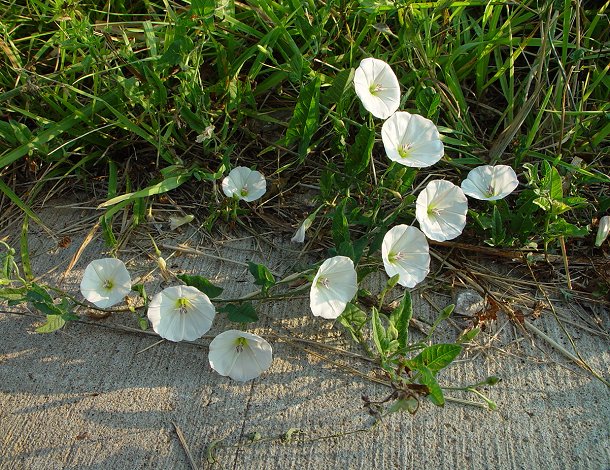Convolvulus arvensis L.
Field Bindweed

Introduced
CC = *
CW = 5
MOC = 60
© DETenaglia
Convolvulus arvensis L.Field Bindweed | |
 |
Introduced CC = * CW = 5 MOC = 60 |
© DETenaglia |
|
Family - Convolvulaceae Habit - Perennial forb with deep-set roots and fleshy rhizomes. Stems - Trailing, twining, to 2 m, glabrous to minutely pubescent, sometimes somewhat angular.
Leaves - Alternate, simple, relatively short-petiolate. Blades 1-5 cm long, ovate, oblong-ovate, or triangular, often with a pair of triangular lobes at the base (then appearing sagittate or hastate), rounded to sharply pointed at the tip, truncate to deeply cordate at the base, the margins otherwise entire or with few shallow teeth on the basal lobes, the surfaces glabrous or less commonly minutely hairy. Petiole to 3 cm long, with adaxial groove, pubescent to glabrous.
Inflorescences - Axillary, the flowers solitary or in loose clusters of 2 or 3, usually long-stalked. Bracts 2, 2-8 mm long, usually distant from the flower, scalelike, much shorter than and not obscuring the calyx, not overlapping, linear to elliptic or obovate, persistent or shed before fruiting. Peduncle to 6 cm, pubescent.
Flowers - Calyx of 5 free sepals, 3-5 mm long, similar in size and shape or the outer 3 slightly shorter and narrower than the inner 2, elliptic to oblong, obovate, or nearly circular, herbaceous, the margins usually hairy, the surfaces glabrous or finely hairy. Corollas 1.2-2.5 cm long, very shallowly 5-lobed, broadly funnelform to nearly bell-shaped, white, often pinkish-tinged, especially with age. Stamens 5, fused to base of corolla tube, lacking subtending scales, not exserted. Filaments to 1 cm long, flattened and broad at base, terete above, clavate pubescent near base, white. Anthers whitish-pink, to 3mm long. Ovary white, superior, 2 mm long, 2-locular, with 4 ovules. Style 1, glabrous, 1 cm long. Stigmas 2, linear in outline, somewhat flattened, 3-4 mm long, white to pale yellow.
Fruits - Capsules 5-7 mm long, globose to ovoid, 2-locular, dehiscing longitudinally, the wall separating into 4 segments, glabrous. Seeds 1-4, 3-4 mm long, oblong-ovate to ovate in outline, somewhat longitudinally angled on the inner face, the surface with small, dense tubercles, dark brown to more commonly black, glabrous. Flowering - May - September. Habitat - Streambanks, crop fields, roadsides, railroads, open disturbed areas. Origin - Native to Europe and Asia. Lookalikes - Calystegia spp. Other info. - This introduced weed is common throughout Missouri. It is present across most of the continental U.S., though rare in the far southeastern region, and Canada as well. It is easily recognized by its pale funnelform flowers and weedy habit. Flowers of plants in the Calystegia genus have flowers which are similar, though usually considerably larger. In those species, the floral bracts closely subtend and largely obscure the calyx, whereas in Convolvulus arvensis these are much smaller and more distant from the flower (see image above). Photographs taken in Springfield, MO., 7-5-03 (DETenaglia); also at Broemmelsiek County Park, St. Charles County, MO, 6-24-2010, Canaan Conservation Area, Gasconade County, MO, 6-6-2013, and Creve Coeur Lake Park, St. Louis County, MO, 8-30-2021 (SRTurner). |